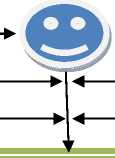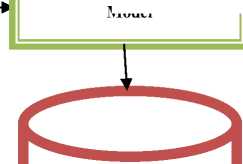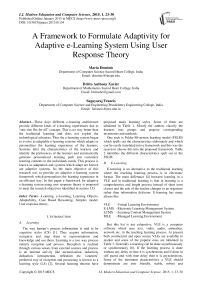A Framework to Formulate Adaptivity for Adaptive e-Learning System Using User Response Theory
Автор: Maria Dominic, Britto Anthony Xavier, Sagayaraj Francis
Журнал: International Journal of Modern Education and Computer Science (IJMECS) @ijmecs
Статья в выпуске: 1 vol.7, 2015 года.
Бесплатный доступ
These days different e-learning architecture provide different kinds of e-learning experiences due to “one size fits for all” concept. This is no way better than the traditional learning and does not exploit the technological advances. Thus the e-learning system began to evolve to adaptable e-learning systems which adapts or personalizes the learning experience of the learners. Systems infer the characteristics of the learners and identify the preferences of the learners and automatically generate personalized learning path and customize learning contents to the individuals needs. This process is known as adaptation and systems which adapt are known are adaptive systems. So the main objective of this research was to provide an adaptive e-learning system framework which personalizes the learning experience in an efficient way. In this paper a framework for adaptive e-learning system using user response theory is proposed to meet the research objectives identified in section 1.D.
Learning, e-Learning, Learning Objects, Adaptability, Case Based Reasoning, Simplex model, User response theory
Короткий адрес: https://sciup.org/15014720
IDR: 15014720
Текст научной статьи A Framework to Formulate Adaptivity for Adaptive e-Learning System Using User Response Theory
Published Online January 2015 in MECS DOI: 10.5815/ijmecs.2015.01.04
-
A. Learning
The way human’s process information is said to be cognitive styles (CS) [1]. They acquire information, recognize and map them to representations and knowledge and use them. Learning is a two way process namely reception and process. Reception is realized through various senses from external sources and process is an internal activity like memorization, induction, deduction, introspection, reflection etc. Learners’ preferred way of reception and processing is known as a learning style (LS) [2]. Several learning theorist have proposed many learning styles. Some of them are tabulated in Table 1. Mostly the authors classify the learners into groups and propose corresponding inventories and methods.
One such is Felder-Silverman learning model (FSLM) which spells out the characteristics elaborately and which can be easily translated into a framework and this was the reason to choose this into the proposed framework. Table 2 identifies the different characteristics spelt out in the FSLM.
-
B. E-Learning
E-learning is an alternative to the traditional learning where the teaching learning process is in electronic format. The main difference [4] between learning in a VLE and in traditional learning is that in learning is a comprehensive and length process instead of short term classes and the role of the teacher changes to an organizer rather than information deliverer. E-learning has many aliases like
VLE –Virtual Learning Environment
E-LMS –Electronic Learning Management System
LCMS –Learning Content Management System
MLE –Managed Learning Environment
But this list is not exhaustive. VLE is a computer software which uses text, video, audio, animation, network etc. in the teaching learning process. At present both commercial and open source VLEs are available in market and some of the popular ones are tabulated in Table 3. Generally e-learning can be done asynchronously or synchronously [6]. If the learning process is done without any delay in time it is synchronous and if done in self paced and with time delay then it is asynchronous. Some of the minimum characteristics a VLE should demonstrate are user friendly, stable, robust and customizable. As the number of courses and the amount of resources increases there is requirement for management process to store the resource, distribute them efficiently and secure them. The main issue in e-learning is sharing and interoperability of the various resources among the different e-learning systems. To promote sharing and interoperability various standards have been published and they are dealt in [7, 8, 9]
Table 1 Learning Styles [3]
|
Author’s |
Characteristic’s |
||||||
|
David kolb’s LMS |
Accommodating |
Diverging |
Converging |
Assimilating |
|||
|
Peter Honey and Alan Mumford’s LMS |
Activists |
Reflectors |
Theorists |
Pragmatists |
|||
|
Dunn and Dunn LMS |
Environmental |
Emotional |
Sociological |
Physiological |
Psychological |
||
|
Felder-Silverman LMS |
Active / Reflective |
Visual / Verbal |
Sensing / Intuitive |
Sequential / Global |
|||
|
Sarasin VAK LMS |
Visual |
Auditory |
Kinesthetic |
||||
Table2 Felder-Silverman Learning Style Models [5]
|
Learning Styles |
Description |
|
Sensory |
Concrete, Pragmatic |
|
Intuitive |
Conceptual, Innovative |
|
Visual |
Preferences to Pictures |
|
Verbal |
Preferences to text/audio |
|
Inductive |
Prefer explanation from concrete to general |
|
Deductive |
Prefer explanation from general to concrete |
|
Active |
Learn by experimentation and collaboration |
|
Reflective |
Learn by thinking |
|
Sequential |
Learn by small steps |
|
Global |
Learn by jumping from one topic to another in a non linear manner |
-
C. Adaptable e-Learning
Adaptability is the ability of the e-learning system to provide personalized contents and learning path based on different parameters and predefined rules. The different parameters can be as follows,
-
• Cognitive skills (CS) by which humans acquire, map, process information, convert them to knowledge and use them. Different authors identify different aspects of CS [10]. Any such suitable algorithm can be used in the proposed framework.
-
• Learning style (LS) identifies the way students learn and acquire knowledge. There exist many classifications of LS as listed in [3]. But Brusilovsky in [11] noticed that it was still not clear which aspect of learning style is worth modeling. Since then many researchers [5] have made efforts to identify the benefits of adaptation and they suggest that different LS should provide different learning sequences.
-
• Subject knowledge Competency levels of the user should be also considered as pointed in [12].
In general there are three kinds of adaptation [13] namely,
-
• Adaptive presentations
-
• Adaptive navigations
-
• Adaptive content
Adaptive presentations are presenting the learning materials adapted according to the learners’ characteristics. Adaptive navigation is the adaptation of the learners’ navigation through the learning path. Adaptive content is the adaptation of the learning resources according to the learner characteristics.
Constraints in adaptability are
-
• Designing and incorporating of adaptive systems are complex and expensive.
-
• Recreation and reuse of LO is difficult.
-
• User need to have pre usage knowledge of the system.
Some of the methods used in the existing adaptive systems are tabulated in Table 4.
-
D. Research Objectives
The research objectives was to develop an efficient framework to provide personalization to the learning activity by considering the following,
-
• Considering Authors’ Knowledge (Static learning path)
-
• Providing new learning paths based on users’ characteristics (Dynamic learning path -DL)
-
• Considering the learners’ feedback on the learning
path and maturing the system (User Response Theory)
-
• Reducing the computing cost by considering the
intelligence accumulated over a period of time (maturity level to be decided by the system developers).
-
II. Framework And Adaptive Formulation
The main goal of this research is to provide adaptivity of the learning contents and the learning sequences based on identification of the users’ characteristics based on a series of tests conducted. Adaptivity is realized using four models in the framework as shown in Fig. 1 and they are,
-
• Learner Preference Model
-
• Case Based Reasoning Model
-
• Simplex Model
-
• Learning Object Repository Model
Some of the common parts that of the proposed framework with the ones already proposed are
-
• Taxonomy of relevant LO in the repository
-
• SCORM compliance for standardization
-
• User LS, CS, Subject Competency (SC) capture and inference
This framework differs with others in the adaptation process by using case based reasoning method and simplex method to perform adaptation using perused learning path or generate new learning path respectively.
-
A. Learners’ Preference Inference Model
From the series of test conducted on the user the following characteristics which influence the learning process are identified.
-
• Learning Style preferred by the learner is formulated as identified from the Felder Silverman Learning
Style Model. Felder-Solomon Questionnaire [36] is used to identify the learning style according to FSLM.
-
• Learners’ Subject competency level. The learners are classified into three categories namely Low Level, Medium Level, Advance Level with weightage 1, 2, 3 respectively.
-
• Personal profile (PP) like gender (male or female), qualification (Under graduation or Post graduation) and domicile (Urban or Rural) are also identified.
-
• Perpetual ability and reasoning skills (PARS) which have attracted much attention in the recent years are also identified [37]. Learner’s psychological characteristics are mainly related with the way they receive, process and store information.
Even though data mining techniques were first applied in e-commerce, different mining techniques can be applied to e-learning systems also. Using these techniques it is possible to perform analysis, predict and identify patterns that will contribute personalization to the elearning environment. Any one of the techniques the developer feels appropriate can be applied in the Learner preference inference model to identify the learner preferences. From the above said activity the learners’ preference is formulated as seen in the generalized form (1).
Learners’ Preference (LP) =
∑(LS(x1, x2,...xn), SC(i), PP(k, l), PARS(i))
Where i stands 1 or 2 or 3
k stands for Male or Female l stands for Urban or Rural
LS is the Learning Style
X i are the Learning Characteristics as in FSLM with appropriate weightage to each
SC Subject Competency with weightage as 1 for low level, 2 for medium level and 3 for advanced level
PP is the Personal profile with weightage 1 for male, 2 or female, 3 for under graduate and 4 for post graduate
PARS is the Perpetual ability and reasoning skills with weightage 1 for low level, 2 for medium level and 3 for advanced level
Table 3 Popular e-LMS
S.no Title URL 1 Apex Learning 2 ATutor 3 Blackboard Learning System 4 Brainshark 5 Chamilo 6 Claroline 7 CERTPOINT Systems 8 Desire2Learn 9 DoceboLMS 10 Dokeos 11 .LRN 12 Latitude learning 13 eFront 14 HotChalk 15 ILIAS 16 Interactyx 17 Moodle 18 Metacoon 19 RCampus 20 Sakai
Table 4 Authors and Methods used for Adapativity
|
Sno |
Authors |
Methods Used |
|
1 |
Baudisch[14] |
Universal queries |
|
2 |
Walker A.et al., [15] |
Collaborative information filtering approach |
|
3 |
Kumar, V., Nesbit.J and Han, K [16] |
Bayesian belief networks |
|
4 |
Lemire.D et al., [17] |
Rule applying collaborative filtering |
|
5 |
Tang, T.Y. and McCalla, G.I [18] |
Learner interest and background knowledge features |
|
6 |
Ya-HuiChen [19] |
Collaborative filtering and item response theory |
|
7 |
Chao-Yu Liu [20] |
Fuzzy item response theory |
|
8 |
Tsai,K.H et al., [21] |
Users’ preferences and neighbor’s interest |
|
9 |
Van Assche,F [22] |
Multi-attribute collaborative filter |
|
10 |
Fengrong et al., [23] |
Collaborative filtering and meta data filtering approach |
|
11 |
Zhiwen Yu et al., [24] |
Ontology based recommender approach |
|
12 |
Gh.A [25] |
Item response theory and artificial neural network |
|
13 |
Abdullah[26] |
Vector space model |
|
14 |
Nasraoui, O [27] |
Content based and collaborative approach |
|
15 |
Garcia,E et al., [28] |
Rule mining approach |
|
16 |
Romero, C et al., [29] |
Web mining approach |
|
17 |
K.I. Ghauth and N.A.Abdullah [30] |
Content based filtering approach |
|
18 |
Abel.F etal., [31] |
Comtella-d discussion forum |
|
19 |
Li, Y et al., [32] |
Web log mining, integrating collaborative filtering (cf), and sequential pattern mining (spm) |
|
20 |
Salehi, M., et al., [33] |
Apriori prefix span algorithm and learner preference tree |
|
21 |
Salehi, M and Nakhai Kamalabadi [34] |
Compact tree, learner preference tree and k-means algorithm |
|
22 |
Salehi, M., Pourzaferani et al., [35] |
Nearest neighborhood algorithm and preference matrix |
Learning Style
Personal Profile
Learner

Subject Competency
Perpetual abilities and Reasoning Skills
Learner Preference Inference Model
Author Identified Learning Path
Preference Characteristics
Prefer Authors’ Learning Path
No
Generate New
Learning Path
Yes
Simplex Model
Yes
No
Pre Used Learning Path ;
Author
Feasible Learning Paths

Learning Objects Repository Model

Components
Static Learning Path
Case Based Reasoning Model

Preference Characteristics +
Learning Path +
User Feedback

Meta Data
Perquisite Level of Difficulty Weight age Objective
Visual
Components
Personalized Learning Contents
Fig. 1. Framework for Adaptive Formulation
From the LP identified in (1) the
next model in the
framework identifies whether the learner is low level
Audio Components
Kinesthetic
Components
subject competent learner or is there is a identical learner preference set of a learner who has already accessed the
system to the new one or is it required to create a new set of feasible solutions (Personalized Contents and Learning path).
-
B. Static Learning Path
If the learner is low level subject competent one or if he prefers to use the authors learning path which will be static in nature then the respective learning object (LO) are collated and presented to the learner as mentioned by the author. In this flow the learning path will be static for all types of learners. But this is provided into the architecture to appreciate the knowledge of the domain creator and for those who prefer to follow the guidelines provided by the author.
-
C. Case Based Reasoning Model
The second alternative is for those who prefer dynamic learning path other than the authors’ static one. This model looks up in the repository for learning patterns which are identical to the new one and fetches the highest user rated solution and presents it to the user.
For the case based reasoning model there is a repository of all the feasible solutions provided to the learners along with the learners’ preferences and their feedback on the feasible solutions provided by the system. For a single user the Simplex model generates different kinds of feasible solutions and all are presented to the user and stored in the case based repository. This is one of the main advantages of the proposed system as other adaptive systems provide only one single solution to the learner and they don’t acknowledge there feedback. In fact the whole learning process is for the learner. This system allows the learners to rate the feasible solutions in a weightage of 1 to 4, 1 being not satisfactory, 2 for satisfactory, 3 for good and 4 for very good. For every time a learner of identical LP access the system, the adaptive learning path feasible solutions stored in the cased based reasoning repository is presented to the learner and he is allowed to give feedback on those learning path which will added with the user feedback value already accumulated and average is found and stored for the feasible solutions. This process of accumulating the learner feedback can be stopped once the system matures and the personalized learning path can be culled for the given LP which will reduce the overall computing cost and also the response time of the system. System maturity limit (number of learners who access the system) can be fixed by developers as per their theories. The storage of the information can be in the following generalized triplet format as given in (2).
LP ^ PLCP ^ UF (2)
Where
LP –Learners’ Preferences
PLCP –Personalized Learning Contents and Path UF –User Feedback Value
This can be implemented in an array data structure and searching can be done by any one of the array searching algorithms. Ontologies can be also used to represent the information to make it semantically inferable.
-
D. Simplex Model
The third model is for the new dynamic learning path (DLP) generation. This model needs to work until the system matures. Many architectures use different dynamic path generation methods as seen in Table 4. The proposed model uses Simplex Model to generate DLP. This model generates optimal solution and feasible solutions for the LP.
The main difference between this model and other models is,
-
• It not only provides optimal solution but also other feasible solutions (different learning paths) to the user.
-
• It allows the user to use them all and rate them, which is used to mature the system.
-
• Once the system matures, ie it accumulate the characteristics of different kinds of learners and their feedback on the solutions gathered, the simplex model need not execute and all pattern generations can be read from the case based reasoning model from its repository.
The different types of e-learners are identified by their Subject Competency (SC), Perpetual Abilities and Reasoning Skills (PARS), Learning Style (LS), Personal Profile (PP), etc. Here we use three parameters m, n and k .
m - the total number of different types of e-learners which is obtained by multiplying the numbers of subdivisions of the characters SC, PARS, LS, PP, etc.
n - the number of learning objects/components like visual, audio, kinesthetic, etc. where the n learning components taken as e 1 ,e2,e3 ,„, en respectively.
The x i =(1,0,_,0), X 2 =(0,1,...,0),....,
X j =(0,0,...1,...,0),...., xn=(0,0,...,1) be the n - dimensional vectors associates with e-learning components e 1 ,e2,e3 ,„, en respectively. All the possible elearning sources are available for the m types of learners such that b 1 = a 11 x 1 + a12x2+...+a1nxn ( learner by 1 )
n
Then bi= Z ajXj j=1
sources which
where i=1, 2,…, m are the learning will be used learners
{ 0 if i ' th learner not use j ' th component
1 if i'th learner use j 'th component k - the maturity level of the system and let feedback weightage score given by the ith learners. All the weightage on bi stored in the system. Then max {all users}
n wb = У awe i i ij i j j=1
for i= 1,2,…,m is the optimal
user based solution which will be served to the users coming after the maturity level k.
-
E. Learning Object Repository
Learning Object (LO) repository consists of the LOs proposed for the learning activity. For each learning object, Meta data about the learning object are also stored to make them more inferable using other types of techniques. Some of the Meta data stored for the LO are
-
• Prerequisite LO for the current LO
-
• Weightage for the LO in the course given by the author
-
• Objective of the LO
-
• Level of difficulty to be used while sequencing the learning path
Every learning object consists of visual, audio and kinesthetic components so those appropriate components suitable for the learner are projected to the learner on the topic. This makes adaptability more meaningful.
-
I II. Conclusion
The main advantages of this framework are
-
• It takes into account the knowledge of the course developer ie the author and provides the learning path he/she has provided for those who wish to follow him or who have low level of subject competency for whom the best possible way is to follow the author.
-
• The simplex model not only provides with a single solution but with a collection of solutions and presents all to the user who can follow any one or use all and finally rate them. This considers and accumulates the feedback of the learners which can be used to rate the learning paths and retrieve which has the highest feedback rate for the LP once the system matures. Until now no other system uses this aspect ie. User response theory. This system keeps on gathering the intelligence from the learning path generation and feedback rating and matures itself so that at one point of time it knows the learning paths required for the various LPs already stored in case based reasoning repository.
-
• In future teaching style models can be implemented along with the appropriate learning style models.
This frame work is being currently implemented using OWL for ontology creation and the User Interface and Business logic being implemented using JSP.
Список литературы A Framework to Formulate Adaptivity for Adaptive e-Learning System Using User Response Theory
- Anita Finke and Janis Bicans. (2010) E-Learning System Content and Architecture Evolution. Proceedings of 16 International Conference on Information and Software Technologies.
- Stash, Cristea and De Bra. (2006) Adaptation to Learning Styles in E-Learning: Approach Evaluation. Proceedings of E-Learn 2006 Conference.
- Lavanya Rajendran and Ramachandran Veilumuthu. (2011) A Cost Effective Cloud Service for E-Learning Video on Demand. European Journal of Scientific Research. p. 569-579.
- O’Reilly. (2004) What is Web 2.0: Design patterns and business models for the next generation of software. Retrieved June 1, 2013 from http://www.oreillynet.com/pub/a/oreilly/tim/news/2005/09/30/what-is-web-20.html in March2012.
- Graf, Viola and Kinshuk. (2006) Representative Characteristics of Felder-Silverman Learning Styles: an Empirical Model. IADIS. p. 235-242.
- http://www.tiresias.org/research/guidelines/e_learning.htm
- www.iicm.tugraz.at/thesis/tdieting_diss.doc
- http://www.researchgate.net/publication/216714984
- Ravet. (2001) Raising the standard of E-Learning, Prometeus Newsletter 5. Retrieved June 1, 2013 from http://www.prometeus.org/news/PROMETEUS_Newsletter5.pdf
- Daniel Burgos, Collin Tattersall and Ron Koper. (2007) How to represent adaptation in e-learning with IMS learning design. Computers and Education: E-Learning – from Theory to Practice.
- Brusilovsky and Miller. (2001) Course delivery Systems for the Virtual University. Access to Knowledge: New Information Technologies and the Emergence of the Virtual University. Tschang F.T. and T. Della Senta.Amsterdam. Elsevier Science and International Association of Universities. p.167-206.
- Chen, S. Y. and G. D. Magoulas. (2005) Adaptable and Adaptive Hypermedia Systems.Hershey. PA. IRM Press.
- Mukta Goyal, Divakar Yadav and Alka Choubey. (2012) E-Learning: Current State of Art and Future Prospects. International Journal of Computer Issues. 9(3). p. 490-500.
- Baudisch.P. (1999) Joining Collaborative and Content-Based Filtering. Proceedings of the SIGCHI conference on. Human Factors in Computing Systems (CHI ‘99) ACM Press.
- Walker, A., Recker, M., Lawless, K. and Wiley. (2004) Collaborative Information Filtering: A Review and an Educational Application. International Journal of Artificial Intelligence in Education. 14(1). p. 3-24.
- Kumar, V., Nesbit, J. and Han, K. (2005) Rating Learning Object Quality with Distributed Bayesian Belief Networks: The Why and the How. 5th IEEE International Conference in Advanced Learning Technologies (ICALT 2005).
- Lemire, D., Boley, H., McGrath, S. and Ball.M. (2005) Collaborative Filtering and Inference Rules for Context-Aware Learning Object Recommendation. International Journal of Interactive Technology and Smart Education. 2(3). p. 685 - 687.
- Tang, T.Y. and McCalla and Smart. (2005) Recommendation for an Evolving E-Learning System: Architecture and Experiment. International Journal of E-Learning. 4(1). p. 105-129.
- Chih-Ming Chen, Hahn-Ming Lee, Ya-Hui Chen. (2005) Personalized e-learning system using Item Response Theory. Computers and Education. 44(3). p. 237-255.
- Chih-Ming Chen, Ling-Jiun Duh and Chao-Yu Liu. (2004) A Personalized Courseware Recommendation System Based on Fuzzy Item Response Theory. IEEE International Conference on e-Technology, e-Commerce and e-Service (EEE’04).
- Tsai, K.H., Chiu,T.K., Lee,M.C. and Wang, T.I.A. (2006) Learning Objects Recommendation Model Based on the Preference and Ontological Approaches. IEEE International Conference on Advanced Learning Technologies.
- Manouselis, N., Vuorikari, R. and Van Assche, F. (2007) Simulated Analysis of MAUT Collaborative Filtering for Learning Object Recommendation. Proceedings of the 1st Workshop on Social Information Retrieval for Technology-Enhanced Learning & Exchange. CEUR-WS.org.
- Gao Fengrong, Xing Chunxiao, Du Xiaoyong and Wang Shan. (2007) Personalised service system based on hybrid Filtering for digital library.Tsinghua Science and Technology. 12(1). p. 1-8.
- Zhiwen Yu, Yuichi Nakamura, Seiie Jang, Shoji Kajita, and Kenji Mase. (2007) Ontology-Based Semantic Recommendation for Context- Aware E-Learning. International Conference on Ubiquitous Intelligence and Computing. Springer Berlin Heidelberg.
- Ahmad Baylari and Montazer, Gh.A. (2009) Design a personalized e-learning system based on item response theory and artificial neural network approach. Expert Systems with Applications. 36(4). p. 8013-8021.
- Khairil Imran, Bin Ghauth and Nor Aniza Abdullah. (2009) Building an E-Learning Recommender System using Vector Space Model and Good Learners Average Rating –Vector space model. 9th IEEE International Conference on Advanced Learning Technologies (ICALT 2009).
- Khribi, M.K., Jemni, M. and Nasraoui, O. (2008) Automatic Recommendations for E- Learning Personalization Based on Web Usage Mining Techniques and Information Retrieval. 8th IEEE International Conference on Advanced Learning Technologies (ICALT 2008).
- Garcia, E., Romero, C., Ventura, S. and Castro, C. (2009) An architecture for making recommendations to courseware authors using association rule mining and collaborative filtering. User Modeling and User-Adapted Interaction. 19(1). p. 99-132.
- Romero, C., Ventura, S., Zafra, A. and De Bra, P. (2009) Applying Web Usage Mining for Personalizing Hyperlinks in Web-Based Adaptive Educational Systems. Computers and Education. 53(3). p. 820-840.
- Ghauth and Abdullah. (2010) Learning Materials Recommendation Using Good Learners’ Ratings and Content-Based Filtering. Educational Technology Research and Development. 58(6). p. 711-727.
- Abel, F., Bittencourt, I.I., Costa, E., Henze, N., Krause, D. and Vassileva, J. (2010) Recommendations in Online Discussion Forums for E-Learning Systems. IEEE Transactions on learning technologies. 3(2). p. 165 - 176.
- Li, Y., Niu, Z., Chen, W. and Zhang, W. (2011) Combining Collaborative Filtering and Sequential Pattern Mining for Recommendation in ELearning Environment. 10th International Advances in Web-Based Learning (ICWL 2011). p. 305-313.
- Salehi, Nakhai Kamalabadi and Ghaznavi Ghoushchi. (2012) Personalized Recommendation of Learning Material Using Sequential Pattern Mining and Attribute Based Collaborative Filtering. Education and Information Technologies. 17(4). p. 1-23.
- Salehi and Nakhai Kamalabadi. (2013) Hybrid Recommendation Approach for Learning Material Based on Sequential Pattern of the Accessed Material and the Learner’s Preference Tree, Knowledge-Based Systems. p. 57-69.
- Salehi, M., Pourzaferani, M. and Razavi, S.A. (2013) Hybrid Attribute-Based Recommender System for Learning Material Using Genetic Algorithm and a Multidimensional Information Model. Egyptian Informatics Journal. 14(1) p. 1-23.
- Münzer and Xiao. (2005) Small Groups Learning Synchronously Online at the Workplace: The Interaction of Factors Determining Outcome and Acceptance. Journal for Universal Computer Science. 11(3). p. 378-393.
- Farell V., Boyle L. and O’Brien. (2008) Educational software that supports the majority learning style. Proceedings of the EdTech conference.


